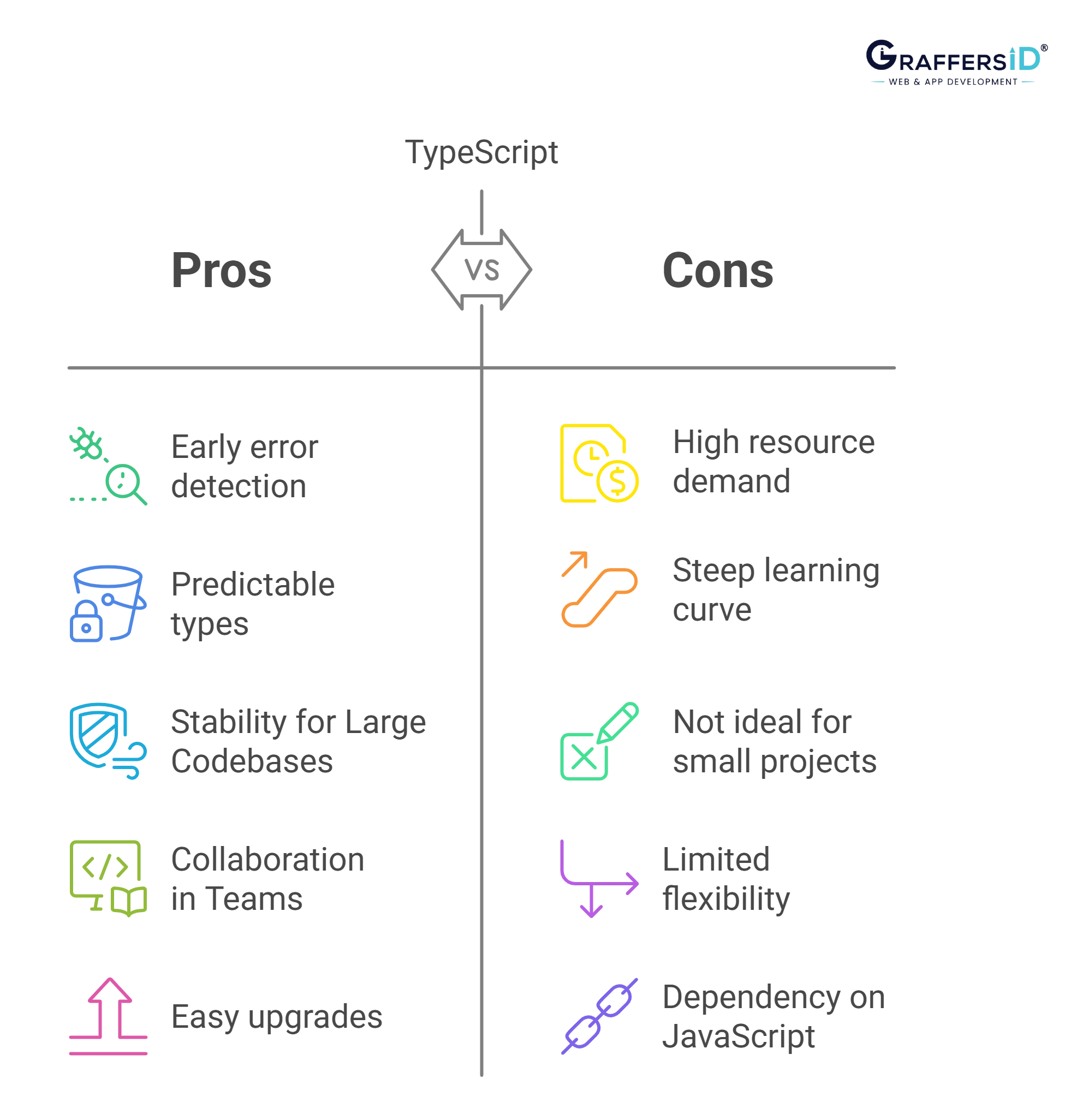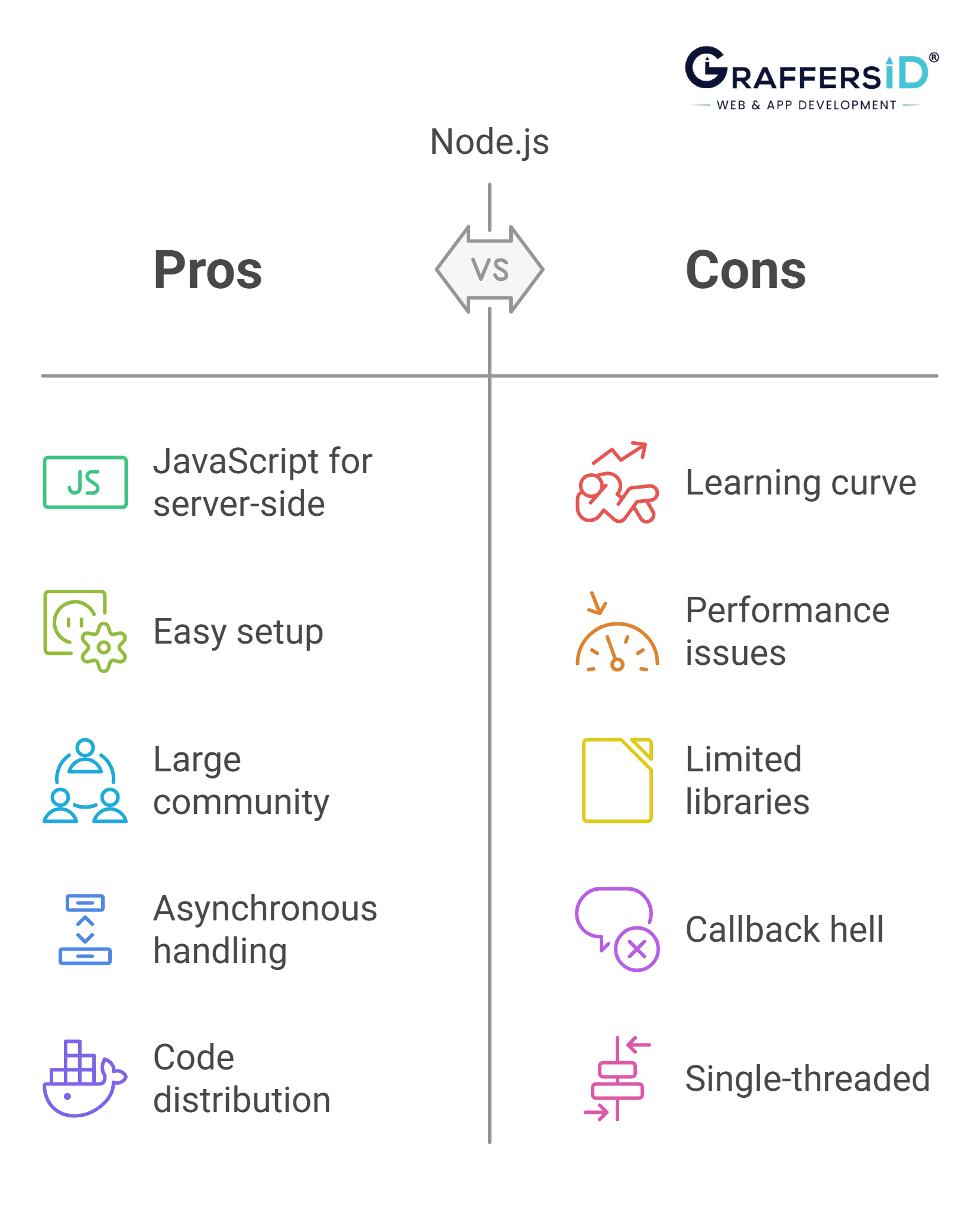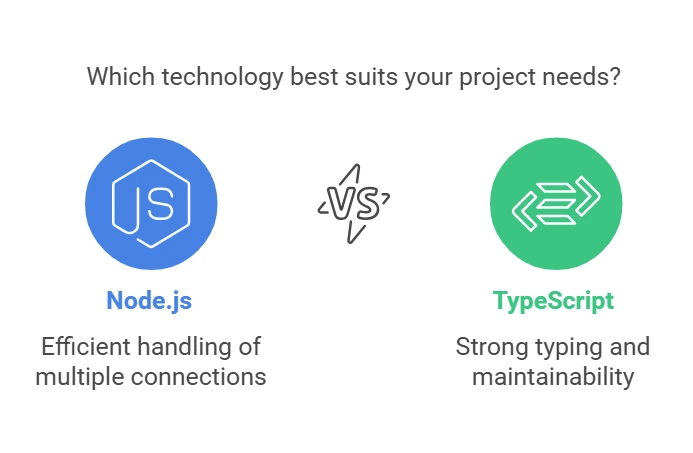JavaScript has become the most popular programming language worldwide because more and more people are working with client-side applications. Due to its variety of technical features and flexible nature, it has captured the attention of numerous developers. Many front-end frameworks, like Vue, Angular, and others, are available to streamline. Its outstanding features have improved the daily job of JS professionals. Additionally, JavaScript is not only appropriate for front-end development. Its extensive functions can also strengthen the server side with effective backend architecture. TypeScript Vs Node.js are the tools that help programmers utilize JavaScript’s backend capabilities. Just like the cricket match, TypeScript vs Node.js plays for their upliftment. Please continue reading to discover their primary characteristics and distinctions.
Overview
TypeScript was developed to enhance JavaScript’s technical capabilities. The availability of static typing makes it easier to spot coding problems before they are apparent in the runtime environment. The open-source programming framework Node.js is used for JavaScript server-side execution.JavaScript programmers use it to streamline business operations and cut costs associated with creating robust applications. This technique allows front-end developers to execute full-stack development without learning another language. In this article, there is more detail about the unique characteristics of both technologies. Let’s dive deep into it.
What is TypeScript?

TypeScript is a programming language that Microsoft created in 2012. There are language and tool components present in this superset of JavaScript. It’s optional static typing helps to spot errors when they occur and even makes it possible for large teams to collaborate. Since TypeScript is built on JavaScript, any TypeScript code may be converted into standard JavaScript using a compiler. But as time passed, programmers realized that JavaScript might also be utilized on the server side.
The language was much improved with new features, but as it evolved and was upgraded, it became clear that JS had grown more complex and burdensome. As a result, TypeScript was created and designed. Typescript is more suitable for large-scale projects with globally distributed teams than JavaScript. It offers several advantageous features that can speed up the development process. Developers get excellent performance and early bug detection during compilation.
Pros and Cons of TypeScript
All the below-given pros and cons of TypeScript will create a clear picture in your mind of its uniqueness.

Pros of TypeScript
- The ability to recognize errors in code at the beginning of a project openly and rapidly is one of TypeScript’s most prominent advantages.
- Furthermore, once software engineers define a type, it doesn’t change and only has predetermined values.
- TypeScript is regarded as a reliable and stable language since it is predictable.
- There are no unanticipated emergencies since types always perform as they should according to how they were specified.
- Additionally, the language is straightforward to read and understand because the developer’s objective in the coding is evident to the other teammates.
- Static typing and adding annotations help to attain this higher level of transparency.
- With TypeScript, it is possible to upgrade applications effectively without making any changes to how they work.
- The system can identify errors on its own and alert users as necessary, which expedites the updating process.
- With TypeScript, programmers can write clean, well-organized code that promotes project expansion.
- Developers can scale the coding if the project’s scope increases beyond what was initially required.
- No matter what platforms or browsers a device uses, it can comparably work with TypeScript if it supports JavaScript.
- This ability to work across several platforms and browsers provides a flexible approach because TypeScript makes it possible to thoroughly transform all the code.
- Furthermore, a vibrant user community supports TypeScript.
Cons of TypeScript
- One of the significant problems with TypeScript is that it demands more time and resources, which isn’t always doable given the project’s size and the client’s particular requirements.
- Developers having a foundation in JavaScript may think TypeScript is easy to understand, but they still need to put in some time and effort to master it.
- TypeScript might not be the ideal solution for small-scale projects.
What Is Node.js?

Node.js is an open-source platform that software engineer Ryan Dahl invented at Joyent. It is a fantastic tool for creating online chats, video streaming websites, SPAs and APIs, social networking and messaging apps, multiplayer games, embedded systems, real-time collaborative tools, and many other projects. Most developers now prefer Node.js as another similar option because it provides versatility, asynchronicity, and event-driven characteristics.
Besides its characteristics, it offers high speed, scalability, and systematized performance, making it more popular in this demanding world. It is unsuitable for applications that demand a lot of CPU power. Statistics show a steady rise in popularity over the past few years, making it possible for Node.js to grow further.
Read Also: Why hiring a Node js Developer is essential for building scalable web apps?
Pros and Cons of Node.js
Node.js is a fast, scalable JavaScript runtime built on the V8 engine, perfect for real-time applications and full-stack development. Learn about the Pros and Cons of Node.js to understand the benefits of the technology.

Pros of Node.js
- JavaScript developers are now able to build server-side apps, and that’s possible because of Node.js’ capabilities.
- This platform’s simplistic structure makes it easy to use and allows for quick setup and use.
- Another benefit is that Node.js has a massive community of developers ready to regularly contribute to developing new toolkits, databases, etc., to enhance the platform.
- Node.js’s event-driven asynchronicity makes it possible to handle requests simultaneously.
- Additionally, it distributes individual pieces of code evenly between the client and server sides.
- With Node.js, massive, heavy files can also be streamed.
- Node.js is considered simple to learn and use because it uses the approachable JavaScript language.
- In contrast to languages like Java, PHP, etc., Node.js provides the opportunity for effective, high-performance programming.
- Its rapid development is the major peculiarity of Node.js in this regard.
- Node.js’s ability to cache data, i.e., to enable secure data storage on the client’s workstation with instant access to it when necessary.
- Additionally, NodeJS-powered applications are incredibly affordable to construct because only JavaScript needs to be written in the front end and back end, not both.
Cons of Node.js
- The most apparent disadvantage is instability and frequent API updates, according to Node.js developers. Developers may encounter many problems which would require more work to find and fix flaws.
- Numerous libraries released without sufficient testing could eventually pose problems for Node.js software developers.
- Node.js’s inability to scale is yet another flaw. You may also encounter difficulties if you want to use relational databases and Node.js.
- Node.js is not the most incredible option for inexperienced developers who are just starting their careers in the business because the association with JavaScript suggests the necessity of in-depth skills in the language.
🆚 TypeScript vs Node.js: Apples and Oranges?
Yes! Because TypeScript is a programming language, while Node.js is a runtime. They’re often used together.
🔹 TypeScript can be used to write code that runs on Node.js.
🔹 Node.js can execute TypeScript code (after compiling it to JavaScript).
So, it’s not about which one to choose, it’s about how to use both effectively.
💡 Use Case Scenarios
| Scenario | Use TypeScript | Use Node.js |
|---|---|---|
| Building scalable enterprise apps | ✅ | ✅ |
| Writing backend APIs | ✅ (with Node.js) | ✅ |
| Need for strong typing & tooling | ✅ | ❌ |
| Real-time apps like chat apps | ✅ (optional) | ✅ |
| Quick scripting or prototyping | ❌ | ✅ |
Learn More: Java vs JavaScript
Difference between TypeScript and Node.js
Now let’s discuss the difference between TypeScript and Node.js.
When deciding which of these two solutions is ideal for your business, we should examine each one according to several criteria. A table is given to compare them and make your decision easier.
🔍 TypeScript vs Node.js: A Detailed Comparison
| Aspect | 🟦 TypeScript | 🟩 Node.js |
|---|---|---|
| 📝 Term | A programming language developed as a superset of JavaScript to add static typing. Helps in building large-scale, maintainable applications. | An open-source, cross-platform JavaScript runtime environment that executes JS outside the browser—ideal for building scalable backend systems. |
| 🚀 Examples of Use | Web apps, enterprise software, mobile apps, robots, embedded systems, server-side logic, games | APIs, real-time apps (chat , video ), IoT devices, e-commerce , payment gateways , CRMs, social media platforms |
| ✅ Major Advantages |
|
|
| ⚠️ Major Disadvantages |
|
|
| 🎯 Focus Area | Static Typing
– Detects type-related bugs at compile time |
Asynchronous I/O
– Handles concurrent requests |
Which is Better: TypeScript vs. Node.js?

In conclusion, it can be said that JavaScript is the best option for small coding projects when qualified engineers are available for the position. However, TypeScript can assist you if you’re working on a bigger project. So, based on your needs, you can decide which works best for you.
Based on JavaScript, two notable contemporary technologies are TypeScript and Node.js. Since the first is a language and the second is a runtime environment, their natures are fundamentally different. The primary consideration you should make when choosing one of them is the specifics of your project. For instance, Node.js has proven excellent for IoT and payment processing systems. For its part, TypeScript is ideal for building web pages full of dynamic and interactive images. Additionally, incredible results can be achieved by combining TypeScript and Node.js. As a result, you can simultaneously benefit from the advantages of both instruments.
If you need any help deciding which technology to use, don’t be afraid to contact our website. Our business is delighted to provide wise advice and help with your tasks. Hire Node.js Developers from GraffersID to get quality results. You can also hire TypeScript developers with apt skills and experience for your development projects.





